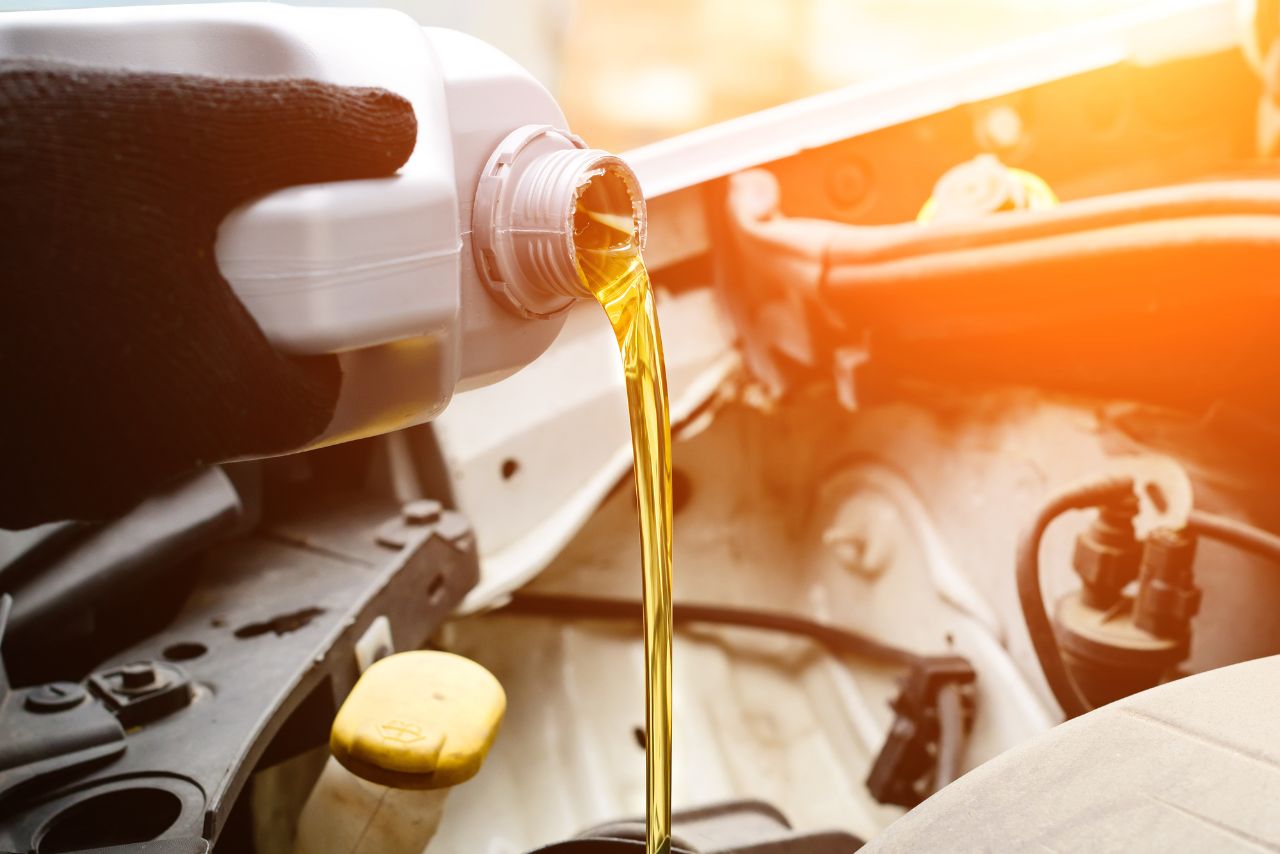You may have noticed that your car’s engine oil appears thicker when the engine is hot. It’s not just your imagination playing tricks on you – engine oil does, in fact, change its viscosity when subjected to high temperatures.
In this article, we’ll delve into the science behind engine oil viscosity Does Engine Oil Get Thicker When Hot, how it affects engine performance, and what you can do to maintain optimal engine oil temperature.
Engine oil viscosity refers to the oil’s resistance to flow. A higher viscosity means the oil is thicker and more resistant to flowing, while a lower viscosity means the oil is thinner and flows more easily.
The viscosity of engine oil is affected by temperature – as the temperature rises, the oil becomes thinner and flows more easily, while as the temperature drops, the oil becomes thicker and more resistant to flow.
This change in viscosity can affect the engine’s performance, making it important to monitor and maintain optimal engine oil temperature.
Table of contents
Understanding Engine Oil Viscosity:
Understanding engine oil viscosity is crucial because it affects how well the oil can protect your engine. The thicker the oil, the higher its viscosity grade. Oil viscosity grades represent the oil’s thickness or resistance to flow.
The Society of Automotive Engineers (SAE) created the viscosity grading system for oils. The system uses numbers to indicate how thick or thin the oil is at different temperatures.
For example, SAE 10W-30 oil means the oil has a viscosity grade of 10 when cold and 30 when hot.
Measuring viscosity accurately is essential to ensure the oil can provide proper lubrication and protection to your engine.
Various methods are used to measure viscosity, including kinematic viscosity, which measures the oil’s flow rate under gravity, and dynamic viscosity, which measures the oil’s resistance to flow under shear stress.
The viscosity of engine oil changes with temperature. When heated, the oil’s molecules move faster, causing the oil to become thinner and less viscous.
When the oil cools down, the molecules move slower, making the oil thicker and more viscous. Therefore, it’s crucial to use the right viscosity grade of oil for your engine to ensure proper lubrication and protection.
Is Engine Oil Thinner when Cold?

The answer is Yes, engine oil is generally thinner when cold. When the temperature drops, the oil’s viscosity increases, meaning it becomes thicker and flows more slowly. This is known as cold temperature or low-temperature viscosity.
Thicker oil can be problematic during cold starts as it may not flow quickly enough to provide sufficient lubrication to critical engine components. It can also lead to increased resistance and drag, affecting engine performance.
To address this issue, engine oils, including synthetic oils, are formulated with additives called viscosity index improvers. These additives allow the oil to maintain a more consistent viscosity across a wide temperature range.
They help prevent excessive thickening when cold, ensuring that the oil flows more easily and reaches critical engine parts faster during startup.
As the engine warms up, these additives undergo a change in structure and allow the oil to thin out, maintaining proper lubrication and protection throughout the operating temperature range.
By having the ability to adjust viscosity based on temperature, engine oils can effectively protect the engine during both cold starts and normal operating conditions.
Does Synthetic Oil Thin out When Hot?

The answer is Yes, synthetic oil does thin out when exposed to high temperatures. Synthetic oils, like their conventional counterparts, undergo a change in viscosity as they are heated. Viscosity refers to the oil’s resistance to flow, and it is influenced by temperature.
When synthetic oil is subjected to increased heat, its molecules become more agitated and move more freely, causing the oil to thin out or decrease in viscosity.
This thinning effect is advantageous in certain situations, such as during cold engine starts, as it allows the oil to flow more easily and provide better lubrication.
However, when the oil reaches operating temperatures, excessive thinning can become a concern.
If the oil becomes too thin, it may struggle to maintain an adequate lubricating film between engine components, potentially leading to increased friction, wear, and reduced protection.
To counteract excessive thinning at high temperatures, synthetic oils are formulated with additives that help stabilize viscosity across a wide range of temperatures.
These additives, known as viscosity modifiers, work by expanding or thickening the oil when it heats up, effectively maintaining a stable viscosity and ensuring proper lubrication even under extreme conditions.
So, while synthetic oil does thin out when hot, its formulation and additives are designed to provide consistent viscosity and reliable lubrication performance across a wide temperature range, helping to protect the engine and maintain optimal performance.
The Science Behind Viscosity:
Viscosity is a fundamental property of fluids that determines their resistance to flow, and it plays a crucial role in the performance of many mechanical systems.
To better understand the science behind viscosity, here are three important things to consider:
-
Viscosity measurement: Viscosity is usually measured using a viscometer, which measures the time it takes for a fluid to flow through a small opening. The longer it takes, the higher the viscosity. This measurement is often expressed in centipoise (cP) or, in the case of engine oil, in SAE viscosity grades.
-
Temperature dependency: Viscosity is highly dependent on temperature. As temperature increases, the viscosity of most fluids decreases. This is because higher temperatures cause the molecules in the fluid to move more quickly and become less organized, which in turn reduces the resistance to flow.
-
Viscosity index: The viscosity index (VI) is a measure of how much viscosity changes with temperature. A higher VI means that the fluid’s viscosity is less affected by temperature changes, while a lower VI means that the fluid’s viscosity changes significantly with temperature.
In general, high VI fluids are preferred for use in mechanical systems, as they provide consistent performance across a range of temperatures.
Understanding the science behind viscosity is essential for properly selecting the right engine oil for your vehicle.
The temperature dependency of viscosity means that engine oil will get thinner as it heats up, which can affect its ability to lubricate and protect the engine.
Therefore, it’s important to choose an engine oil with a viscosity grade that’s appropriate for the typical operating temperature of your engine and its mechanical system.
By doing so, you can ensure that your engine runs smoothly and efficiently, and that it lasts for many years to come.
Factors Affecting Engine Oil Performance:
When it comes to engine oil performance, there are three key factors you need to consider: the type of oil you’re using, the condition of your engine, and the environmental factors that can impact oil performance.
Type of Oil:
Choosing the right oil for your engine can make a big difference in its performance and longevity. There are several types of oils available in the market, and each one has its unique properties.
Some oils are designed for high-performance engines, while others are meant for low-performance ones. The type of oil you choose will depend on the type of vehicle you have, the manufacturer’s recommendations, and your driving habits.
When it comes to heat resistance, there are three main types of oils: mineral, synthetic, and semi-synthetic. Mineral oils are the least heat resistant and tend to break down quickly under high temperatures.
Synthetic oils, on the other hand, are the most heat resistant and can withstand extreme temperatures without breaking down.
Semi-synthetic oils, as the name suggests, are a blend of mineral and synthetic oils and offer a balance between heat resistance and affordability.
Ultimately, the type of oil you choose will depend on your engine’s specific needs and the conditions in which you drive.
Condition of Engine:
If you neglect the condition of your engine, you’ll likely experience issues with its performance and longevity.
This includes the impact of engine oil on fuel efficiency. Engine oil additives can help improve fuel efficiency by reducing engine friction and wear.
However, the condition of the engine also plays a crucial role in determining how well the oil performs.
A well-maintained engine will allow the oil to flow smoothly and maintain its viscosity even when hot. On the other hand, a poorly maintained engine can cause the oil to break down and lose its viscosity, leading to increased friction and wear.
This can ultimately result in decreased fuel efficiency and engine performance. Therefore, it’s important to regularly maintain your engine and use high-quality engine oil to ensure optimal performance and longevity.
| Factor | Impact | |||
|---|---|---|---|---|
| Engine condition | Well-maintained engine allows oil to maintain viscosity | |||
| Oil additives | Reduce engine friction and wear, improving fuel efficiency | Oil quality | High-quality oil reduces engine deposits and provides better lubrication for improved engine performance |
Environmental Factors:
To truly take care of your vehicle, you must consider the impact of environmental factors on its performance and preservation.
The environment in which you operate your vehicle can have a significant effect on the thickness of the engine oil. Here are three factors to consider:
-
Temperature: High temperatures can cause engine oil to thin out, which can lead to poor lubrication and increased engine wear. On the other hand, low temperatures can cause engine oil to thicken, which can make it more difficult for the engine to start.
-
Humidity: Humidity can also affect the thickness of engine oil. High levels of humidity can cause the oil to absorb moisture, which can lead to thickening and reduced engine performance. Low levels of humidity can cause the oil to evaporate, which can also lead to thinning and reduced lubrication.
-
Altitude: Altitude can impact engine oil thickness due to changes in air pressure. At high altitudes, air pressure is lower, which can cause engine oil to thin out. This can lead to increased engine wear and reduced performance.
It’s important to take these environmental factors into consideration when choosing engine oil and implementing sustainability measures to preserve the performance of your vehicle.
Properly maintaining and changing the engine oil according to manufacturer recommendations can help ensure optimal engine performance and longevity.
Consequences of Overheating Engine Oil:
When engine oil overheats, it becomes thicker and less effective at lubricating the engine’s moving parts.
This can have serious consequences on the performance and longevity of your engine. The effects of overheating engine oil can range from increased engine wear to complete engine failure.
- One of the most significant effects of overheating engine oil is the reduction in lubrication. When oil becomes thick, it cannot flow as easily through the engine’s moving parts, which can cause friction and wear.
- Over time, this can lead to damage to the engine’s internal components, such as the pistons, valves, and bearings. T
- o prevent this from happening, it is essential to change your engine oil regularly and use the correct viscosity oil for your engine.
- Proper oil change intervals are crucial to ensure that your engine is receiving the right amount of lubrication to keep it running smoothly.
| Positive Emotions | Negative Emotions |
|---|---|
| Confidence | Anxiety |
| Security | Frustration |
| Satisfaction | Disappointment |
Incorporating a table can evoke an emotional response in the audience and help them understand the importance of maintaining their engine properly.
Seeing the positive and negative emotions associated with proper engine maintenance can encourage individuals to take action to protect their engine.
By staying on top of oil changes and ensuring that their engine is not overheating, individuals can feel confident, secure, and satisfied, while avoiding the anxiety, frustration, and disappointment that can come with engine failure.
How to Monitor Engine Oil Temperature?
To monitor your engine oil temperature, you can rely on three key tools: the engine oil temperature gauge, warning lights, and regular maintenance.
The temperature gauge is a crucial instrument that provides real-time readings of the oil temperature, allowing you to detect any dangerous increases in temperature that could damage the engine.
Warning lights are another useful tool that immediately alert you to any issues with the oil temperature, and regular maintenance can help prevent problems from occurring in the first place.
Engine Oil Temperature Gauge:
As you cruise down the road, keep an eye on that engine oil temperature gauge – it’s like the heartbeat of your car’s vital fluids.
The engine oil temperature gauge is an essential tool that helps you monitor the temperature of your engine oil.
It provides accurate readings that can help you identify potential issues with your engine oil and prevent costly repairs in the long run.
Here are three important things to keep in mind when using an engine oil temperature gauge:
-
Engine oil temperature gauge accuracy is crucial. If the gauge isn’t functioning properly, it may display inaccurate readings that could lead to incorrect interpretations. Make sure to calibrate the gauge regularly and replace it if necessary.
-
The impact of engine oil temperature on fuel efficiency can’t be overstated. When the engine oil temperature is too high or too low, it can affect your car’s fuel efficiency. High oil temperatures can cause the engine to consume more fuel, while low oil temperatures can decrease fuel efficiency by slowing down the engine’s performance.
-
It’s important to monitor the engine oil temperature gauge regularly. By keeping an eye on the gauge, you can detect any changes in the engine oil temperature and take necessary measures to prevent potential damage to your car’s engine.
Warning Lights:
Hey, you should keep an eye out for those warning lights on your dashboard – they could save you from some serious trouble on the road.
Warning lights are there to alert you to issues with your vehicle, and ignoring them could lead to costly repairs or even accidents.
One common warning light that relates to engine oil breakdown is the oil pressure warning light. This light will typically appear as an oil can symbol, and it indicates that the oil pressure in your engine has dropped below a safe level.
Ignoring this warning light could lead to serious engine damage, as low oil pressure can cause increased friction and heat, which can result in parts wearing out or seizing up. To avoid this, it’s important to check your oil regularly and keep it topped up.
You should also pay attention to any other warning lights that appear on your dashboard, as they could be indicating other issues that need attention.
Here’s an example of a table that shows some common warning lights and what they could mean:
| Warning Light | Possible Meaning | Action to Take |
|---|---|---|
| Oil pressure warning | Low oil pressure | Check oil levels and pressure, top up if necessary |
| Check engine light | Various issues with engine | Take to a mechanic for diagnostic testing |
| Battery warning | Low battery charge | Check battery and charging system |
| ABS warning | Issues with anti-lock brakes | Take to a mechanic for diagnostic testing |
| Airbag warning | Issues with airbag system | Take to a mechanic for diagnostic testing |
By keeping an eye out for warning lights and taking action when necessary, you can help prevent engine damage and keep your vehicle running smoothly. So don’t ignore those warning lights – they could save you a lot of trouble in the long run.
Regular Maintenance:
Regular maintenance is key to keeping your vehicle running smoothly and avoiding costly repairs down the road. One of the most important aspects of regular maintenance is getting timely oil changes and filter replacements.
Engine oil not only lubricates the moving parts but also cleans and cools the engine. Over time, engine oil breaks down and becomes less effective in doing its job.
This can lead to increased wear and tear on the engine, decreased fuel efficiency, and even engine failure.
To keep your engine running smoothly, it’s recommended to get an oil change every 5,000 to 7,500 miles or as recommended by your vehicle manufacturer. Additionally, it’s important to replace the oil filter at every oil change.
The oil filter removes contaminants and debris from the oil, preventing them from circulating through the engine and causing damage.
Neglecting to change the oil and filter can lead to a buildup of sludge and debris in the engine, which can eventually lead to costly repairs.
So, be sure to stay on top of your oil change and filter replacement schedule to keep your vehicle running smoothly and avoid expensive repairs.
Tips for Maintaining Engine Oil:
To keep your engine oil in top condition, you’ll want to follow a few simple tips.
- First, it’s important to regularly change your oil. This is because oil can become contaminated with dirt and debris, which can cause it to lose its lubricating properties and become less effective at protecting your engine.
- Additionally, changing your oil regularly can help you catch any potential problems before they become serious, as the oil can provide clues about the condition of your engine.
- Another important tip is to choose the right oil filter. The oil filter is responsible for removing contaminants from the oil as it circulates through your engine. Choosing a high-quality filter can help ensure that your oil stays clean and free of harmful particles.
- When selecting a filter, look for one that’s designed to fit your specific make and model of vehicle, and make sure it meets the recommended specifications for your engine.
By following these simple tips, you can help ensure that your engine oil stays in top condition, and your engine runs smoothly for years to come.
Common Myths About Engine Oil:
You might have heard some surprising myths about engine oil that could make you question what you know.
It’s important to separate fact from fiction when it comes to maintaining your vehicle’s engine. Here are some common misconceptions about engine oil:
| Myth | Fact |
|---|---|
| You need to change your oil every 3,000 miles. | Modern engines and oils can go much longer between oil changes. Check your owner’s manual for the manufacturer’s recommended oil change interval. |
| Thicker oil is better for your engine. | Using oil that is too thick can actually harm your engine’s performance. Stick to the manufacturer’s recommended viscosity for your vehicle. |
| You can use any oil in your engine. | Not all oils are created equal. Make sure you are using the appropriate oil for your vehicle’s engine type and conditions. |
Busting myths and misconceptions about engine oil is important to ensure the longevity and optimal performance of your vehicle’s engine.
Don’t fall for common misconceptions and always rely on your owner’s manual and a trusted mechanic for guidance on maintaining your engine oil.
Environmental Impact of Engine Oil:
Now that we’ve debunked common myths about engine oil, let’s talk about its environmental impact.
As a vehicle owner, it’s important to not only maintain your car’s health but also consider its effect on the environment.
Used engine oil can have a detrimental effect on the environment if not disposed of properly. Here are some facts about its impact:
- Used engine oil can contain harmful chemicals like lead, arsenic, and cadmium.
- These chemicals can seep into the soil and water supply, contaminating them for years to come.
- Just one gallon of used oil can contaminate one million gallons of water.
However, used engine oil can be recycled and reused, significantly reducing its carbon footprint.
To properly dispose of used engine oil, you can take it to a recycling center or have it collected by a waste management company. Remember, every little effort counts in preserving our planet.
Frequently Asked Questions:
What are the different types of engine oil and how do they compare in terms of viscosity?
There are several types of engine oil, including mineral, synthetic, and semi-synthetic. Viscosity is affected by oil additives and changing oil brands. It’s important to choose an oil with the correct viscosity for your engine’s needs.
Can using the wrong type of engine oil cause damage to my engine?
Like a car on the wrong road, using the wrong engine oil can have potential consequences. Signs of damage caused by using the wrong type include decreased performance, increased wear and tear, and engine failure. Preventive measures include following guidelines for selecting the correct engine oil type.
How often should I change my engine oil?
To ensure optimal engine performance, change your oil every 5,000-7,500 miles or as recommended by your vehicle manufacturer. Signs of needing an oil change include dark, dirty oil and engine noise. Benefits of synthetic oil include improved fuel efficiency and longer intervals between changes.
Is synthetic engine oil better than conventional engine oil?
Did you know that using synthetic engine oil can save you up to $64 per year compared to conventional oil? While it may not be necessary to switch for older vehicles, synthetic oil provides better protection and lasts longer, making it cheaper in the long run.
How does cold weather affect engine oil viscosity?
Cold weather causes engine oil to become thicker, which can impact engine performance and fuel economy. High altitude can further exacerbate this effect. It is crucial to regularly check oil levels in extreme temperatures to ensure optimal engine function.
Conclusion and final thoughts 💭
Congratulations! You now have a better understanding of engine oil viscosity and how it performs in different temperatures.
As you’ve learned, engine oil does indeed get thicker when hot due to the scientific principles of viscosity.
Understanding how engine oil works and the factors that affect its performance can help you maintain optimal engine health and avoid costly repairs.
To monitor engine oil temperature and maintain proper viscosity, it’s important to check your oil regularly and follow manufacturer recommendations for oil changes and filter replacements.
Remember that overheating engine oil can have serious consequences, including engine damage and decreased fuel efficiency.
In conclusion, engine oil is like a finely tuned orchestra. Each component plays a critical role in ensuring the engine runs smoothly and efficiently.
By understanding the science behind viscosity and taking proactive measures to maintain your engine oil, you can keep your vehicle performing at its best. So, keep your engine oil in tune, and enjoy the ride!
Latest Posts:
- Can WD-40 Remove Scratches on Cars? (Hint: Yes, but…)
- Can You Use a Drill to Polish Your Car? (We Tried it Out!)
- Should You Cover Car Scratches With Stickers? (REVEALED!)
- Buick Service Stabilitrak: (Causes & 100% Guaranteed Fix!)
- Common Holden Trax Problems (Causes & 100% Proven Fixes!)
- Jeep Commander Transmission Over Temp: (Guaranteed Fix!)












Leave a Reply